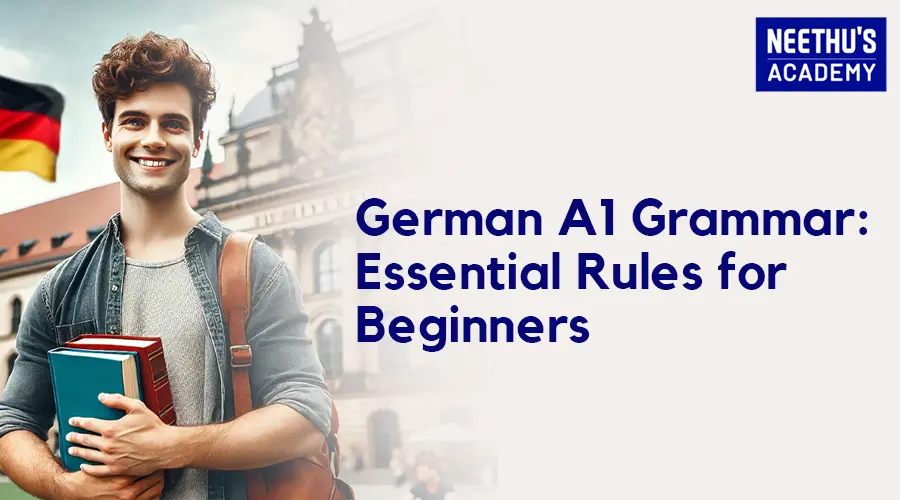What are the Different Levels of the German Language?
According to the Common European Framework of Reference for Languages (CEFR), a standardized framework for assessing language proficiency across Europe there are six levels of language proficiency in German starting right from beginner level to mastery, with descriptors outlining the skills and abilities expected at each level. Here are the CEFR-defined levels of the German language:
A1 – Beginner:At the German A1 level, learners are able to understand and use familiar everyday expressions and very basic phrases. The German A1 exam is more of a basic level where the learner will be able to introduce themselves, ask and answer simple questions about personal details, and engage in basic conversations regarding everyday situations. A1 German level learners are keen on improving clear, slow speech to comprehend conversations fully.
A2 – Elementary: While progressing to A2 level of German, the learners already have a basic understanding of German and are able to communicate in simple phrases using German. Here the learners can describe aspects of their background, immediate environment, and daily activities. A2 level learners have more developed confidence in involving on basic conversations and expressing themselves within familiar contexts.
B1 – Intermediate: B1 level German showcases an advancement in proficiency, where learners can understand the conversations in any contexts related to daily life like work, school, or leisure. After completing the B1 course German they are capable of handling any language situations with simple connected texts on familiar subjects, and engage in meaningful conversations.
B2 – Upper Intermediate: Advancing to B2 level of German proficiency, learners finally have a strong hold and a good command of German. Here, the learners are capable of understanding complex texts and interacting fluently with native speakers. They can express themselves clearly and in detail on a wide range of topics, both orally and in writing, and effectively navigate various social, academic, and professional contexts.
C1 – Advanced: The C1 level is also called the advanced level where the learners possess a strong command and comprehension over German. The learners are capable of understanding demanding, longer texts and expressing themselves fluently and spontaneously without pauses. They can communicate effectively in social, academic, and professional settings, expressing nuanced ideas and opinions with ease.
C2 – Proficient: The C2 level of German represents the highest supreme level of language proficiency, where learners are good at communication just like the native speakers. The C2-level speakers exhibit near-native fluency and are proficient communicators across diverse linguistic situations.
The above mentioned differentiations in the different language levels depend on the CEFR-defined level. The structured framework of CEFR helps the learners to assess and track their progress in mastering the German language, guiding them towards fluency and proficiency.
The German Language Levels Explained
The Common European Framework of Reference for Languages (CEFR) is a widely recognized standard for assessing language proficiency. For every German aspirant ranging from A1 for beginners to C2 for proficiency levels of German language. Let’s look at how each level is overviewed in terms of topics covered, rate of speech, pronunciation and grammar, and vocabulary.
A1 Level, also called the beginner level, is for those who have no prior knowledge of German.
- Topics covered: Basic topics like introductions, personal information regarding family,work, shopping, and daily routines.
- Rate of Speech: Speech is slow and clear to accommodate beginners without intervention.
- Pronunciation and Grammar for rectifying simple grammatical structures.
- Vocabulary: Basic vocabulary provided required for everyday conversations, activities, and common expressions.
A2 Level or the Elementary Level builds upon the basics introduced in A1.
- Topics covered: Expanded topics such as ones required regarding travel, accommodation, health, and work.
- Rate of Speech is relatively slow, but with increased complexity as it is working on a level upgraded from foundational level.
- Pronunciation and Grammar is more complex as the grammatical structures are introduced, along with real grammar rules.
- Vocabulary expands to cover a wider range of daily life contexts.
B1 Level or the Intermediate Level focus on where the learners at this level can communicate in everyday situations with some fluency.
- Topics Covered: This level works more on abstract concepts such as opinions, plans, and past experiences of the learner.
- Rate of Speech becomes faster and more natural, resembling more of real-life conversations.
- Pronunciation and Grammar focus on refining pronunciation with th complex grammatical structures.
- Vocabulary expands and builds to include more specialized terms related to work, hobbies, and social interactions.
B2 Level or the Upper Intermediate Level where the learners will have a good command of the language and are capable of engaging in discussions on various topics.
- Topics covered will be diverse as it may include current events, cultural topics, and abstract ideas.
- Rate of Speech of learners are good as they can understand natural speech at a normal pace.
- Pronunciation and Grammar where emphasis is to have a near-native pronunciation and thereby mastering advanced grammar.
- Vocabulary is just like that of the native speaker which includes idiomatic expressions and colloquialisms.
C1 Level or the Advanced Level where learners have near-native proficiency and can understand complex texts and express themselves fluently in German.
- Topics covered include a wide range of subjects, such as literature, politics, and philosophy.
- Rate of Speech**: Learners can understand fast-paced speech with minimal difficulty.
- Pronunciation and Grammar relies on refining pronunciation to sound native-like and mastery over even subtle grammatical nuances.
- Vocabulary widens the scope and includes specialized terminology across various domains.
C2 Level or the Proficient Level, learners have reached a level of proficiency comparable to that of a native speaker.
- Topics covered includes discussions on abstracts of any topic and understand complex texts with ease.
- Rate of Speech is with ease and can pick up on minor nuances and subtleties of the language.
- Pronunciation and Grammar is quite indistinguishable from that of a native speaker where the learner’s language resembles very similar to the native speaker.
- Vocabulary is extensive within the structured framework of the language.
The CEFR levels provide learners with a structured framework to assess and develop their proficiency in the German language to know the German language better.
FAQs





